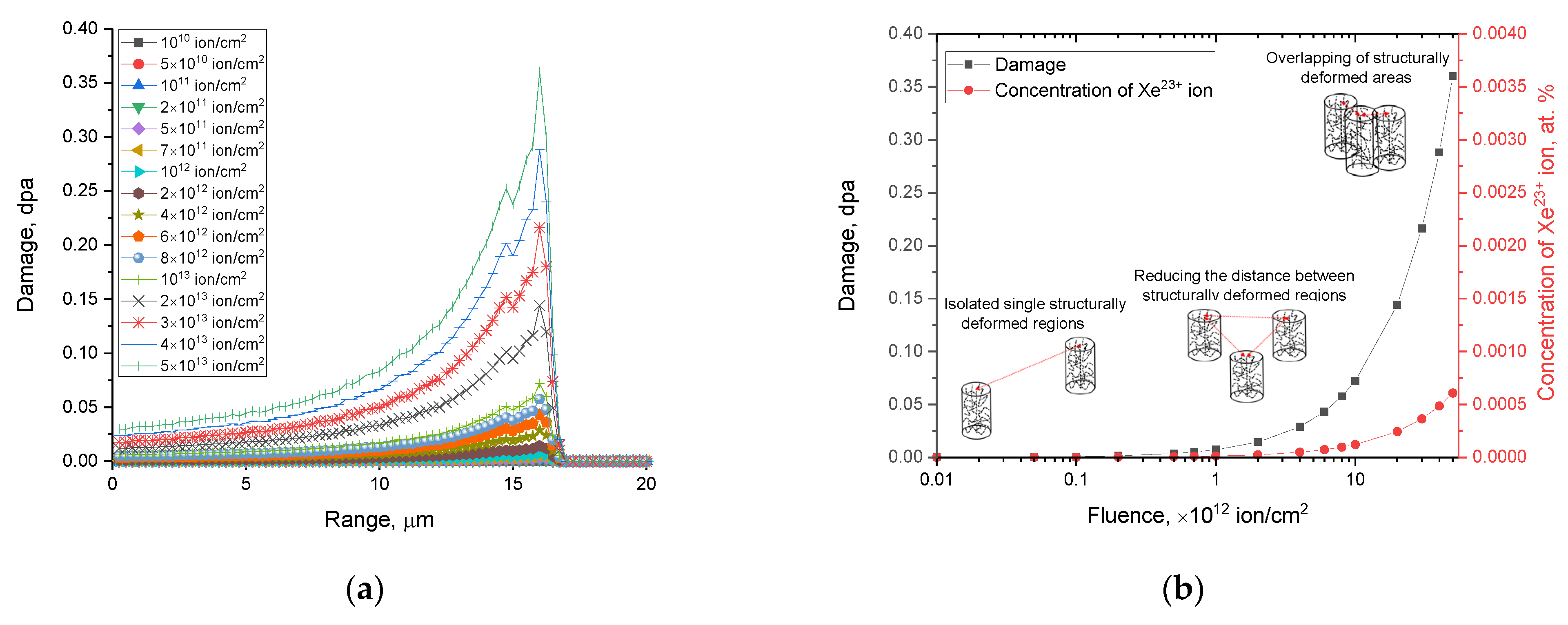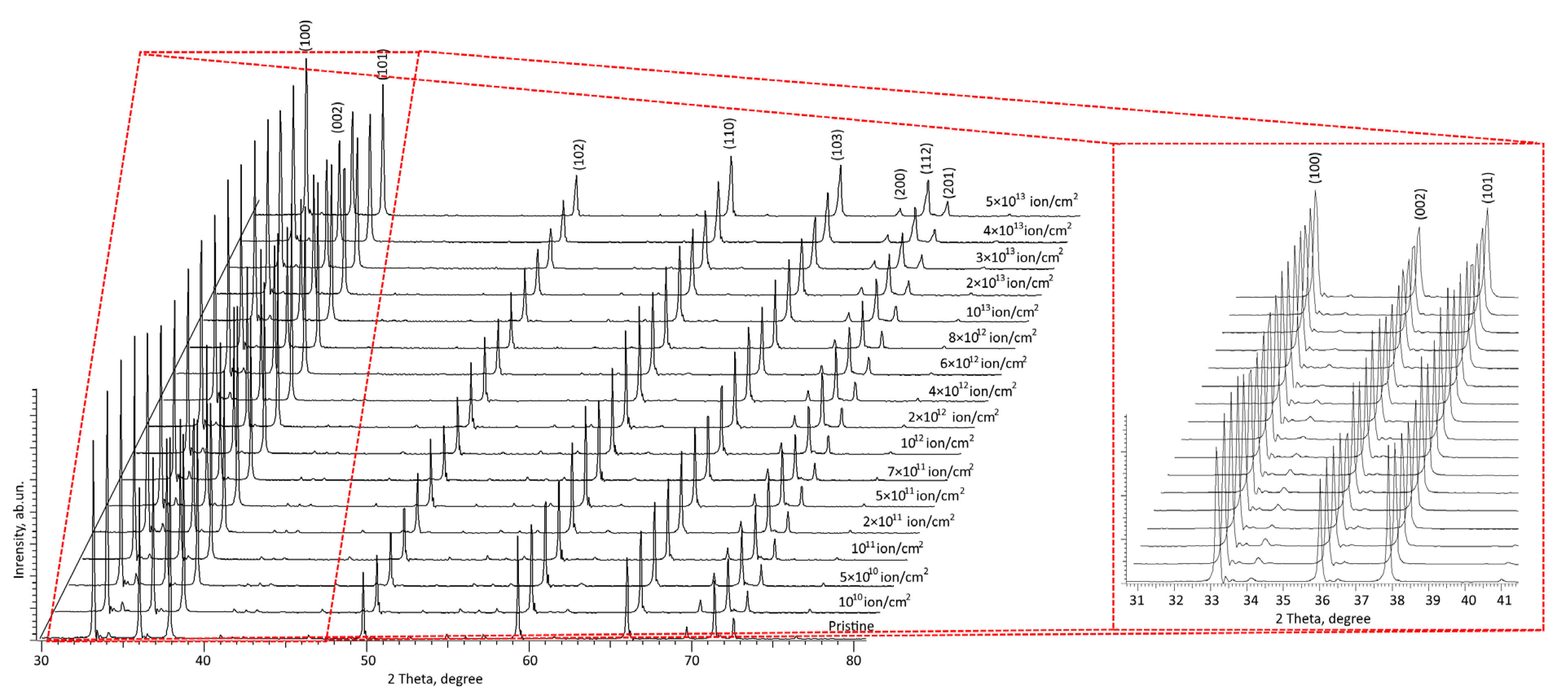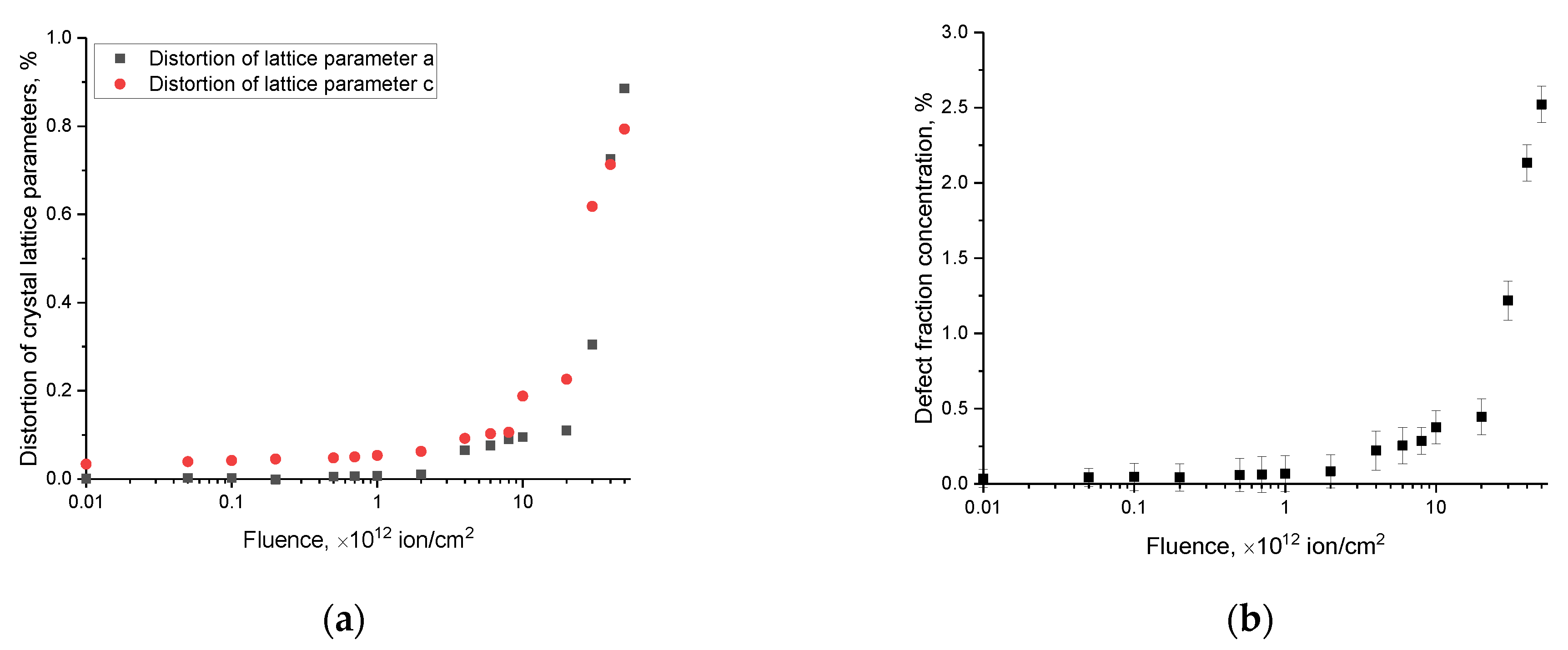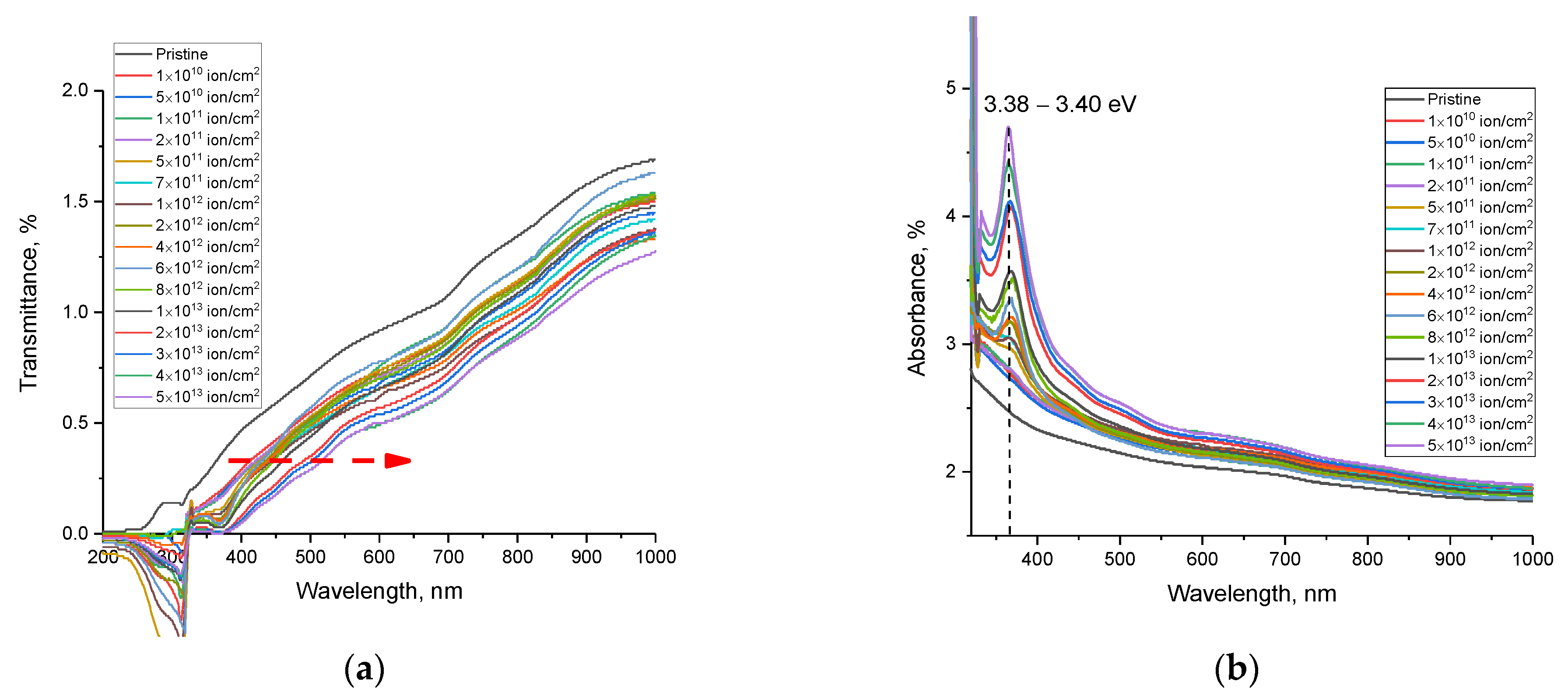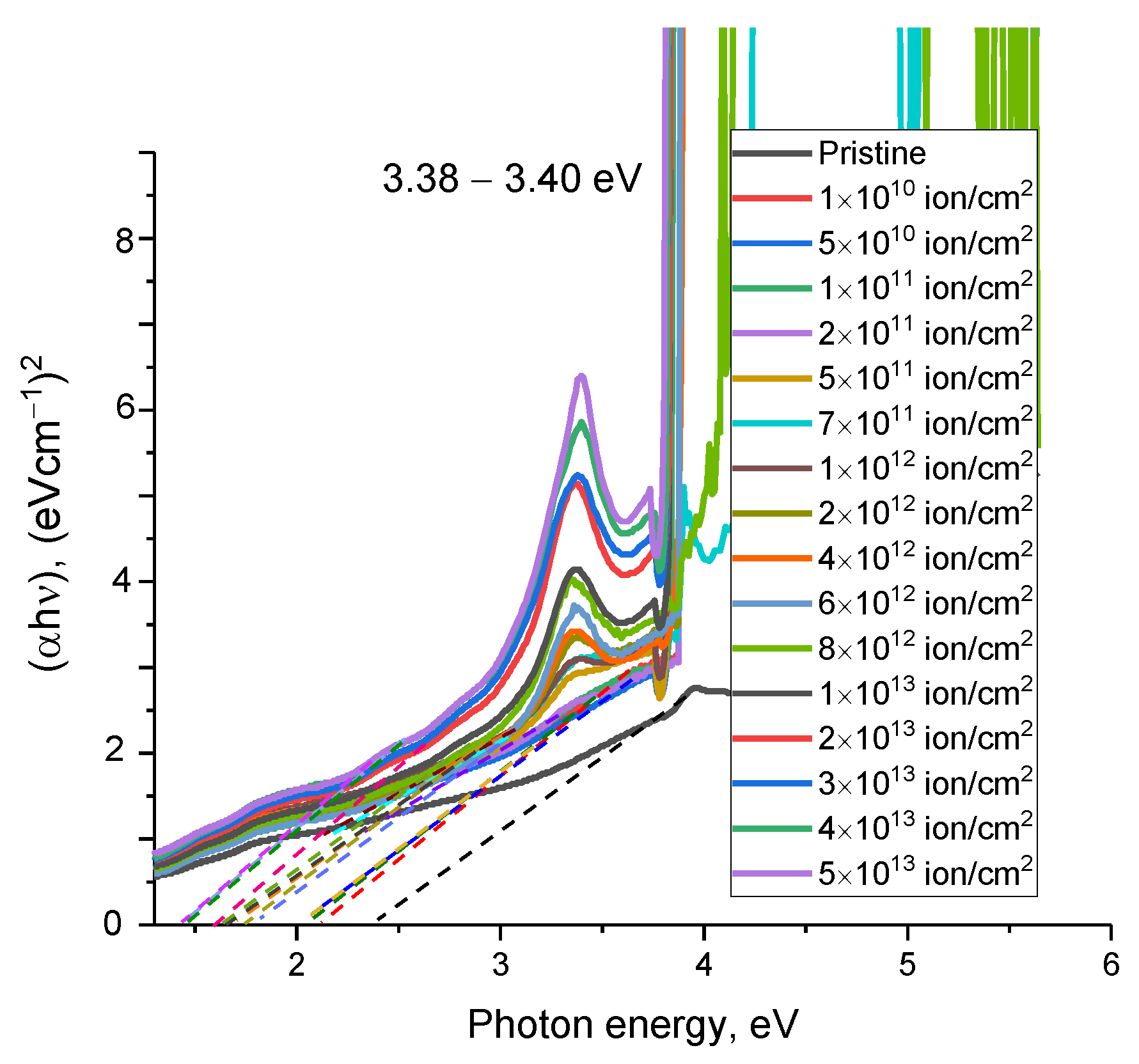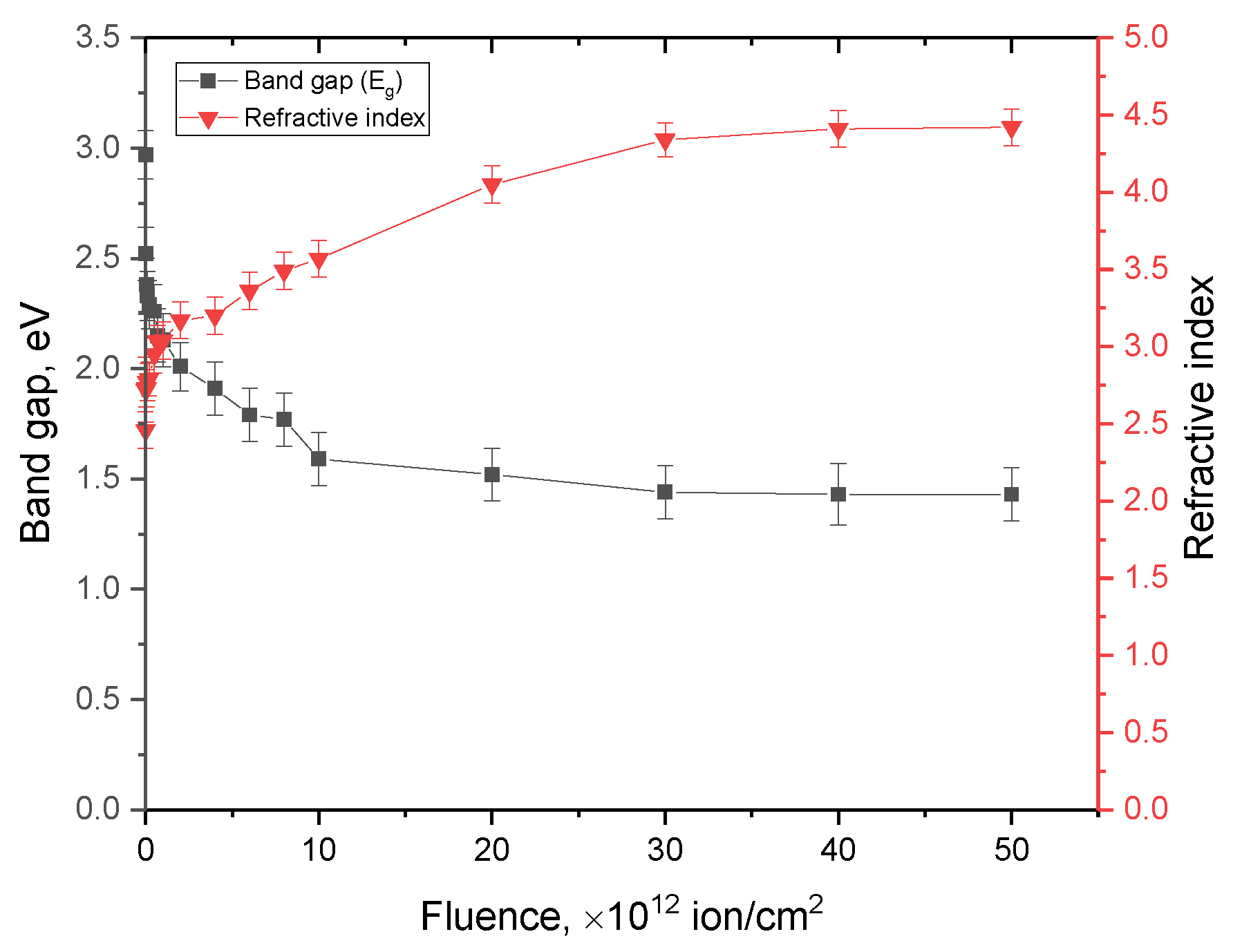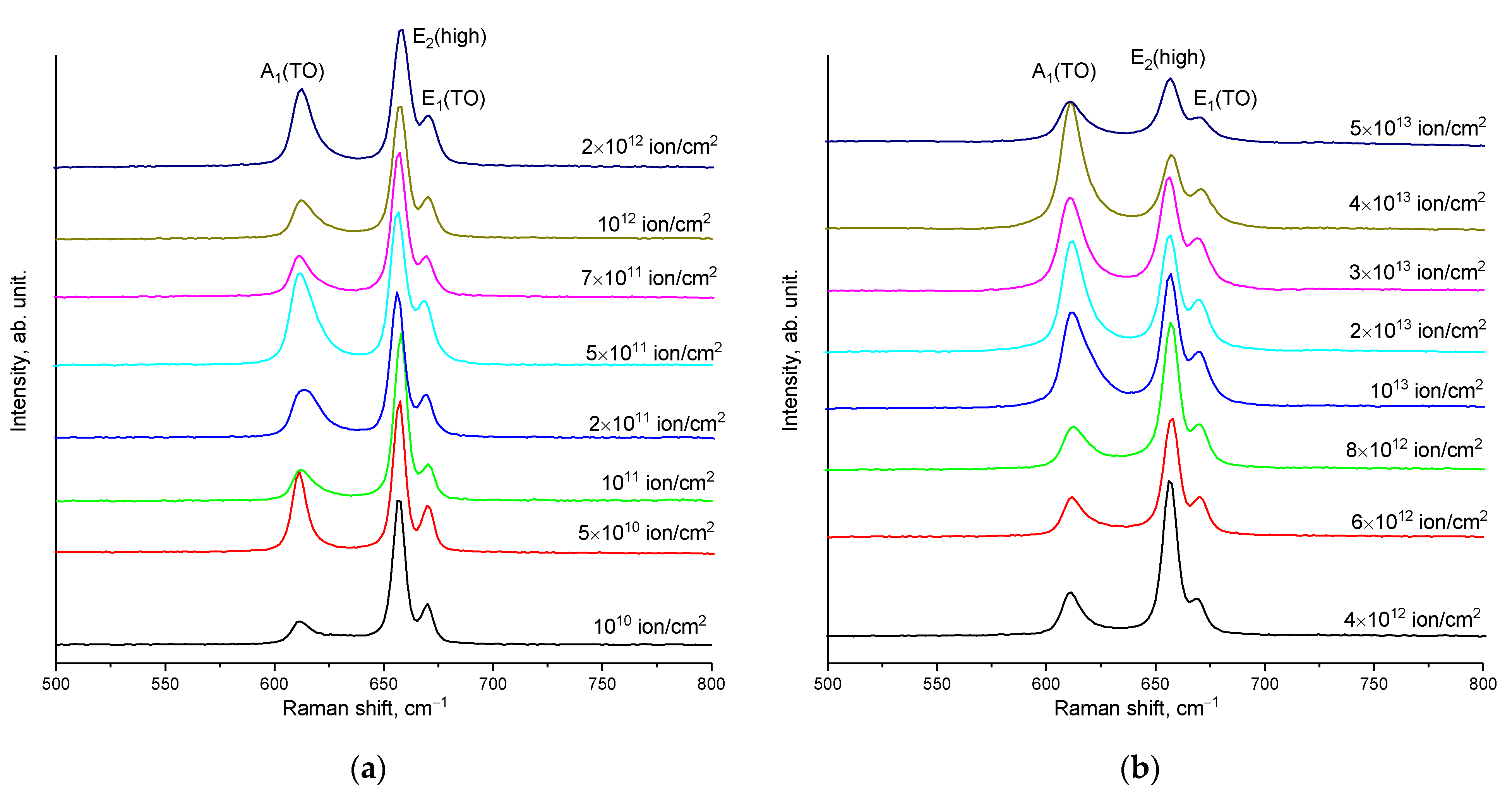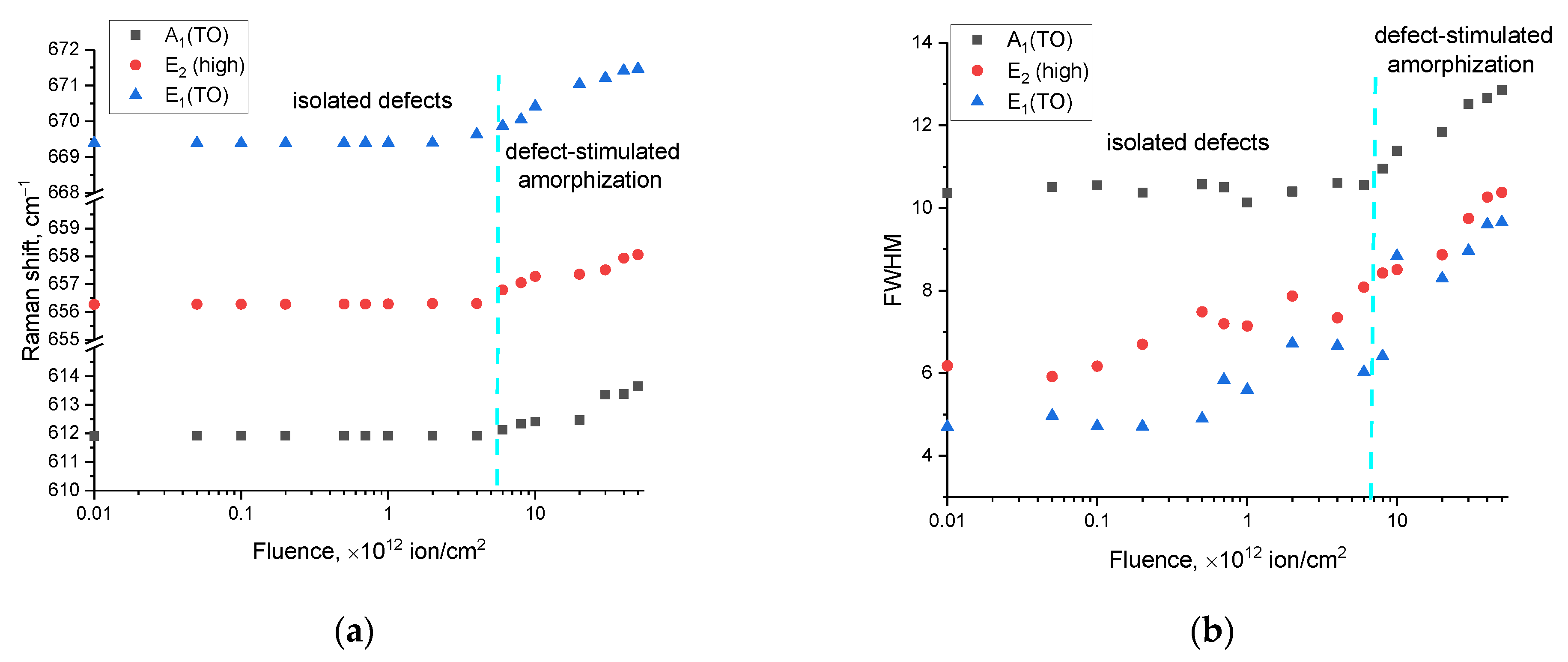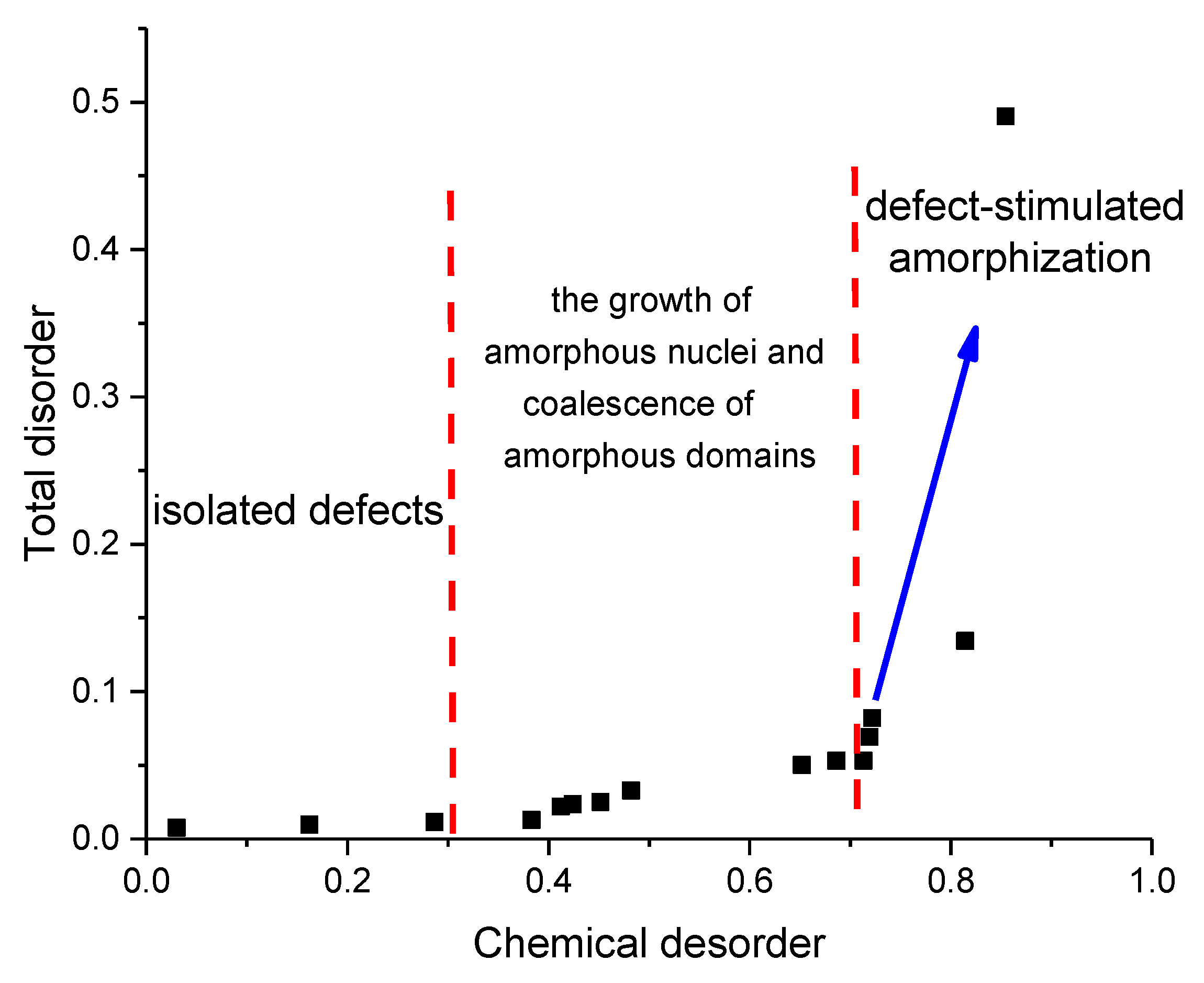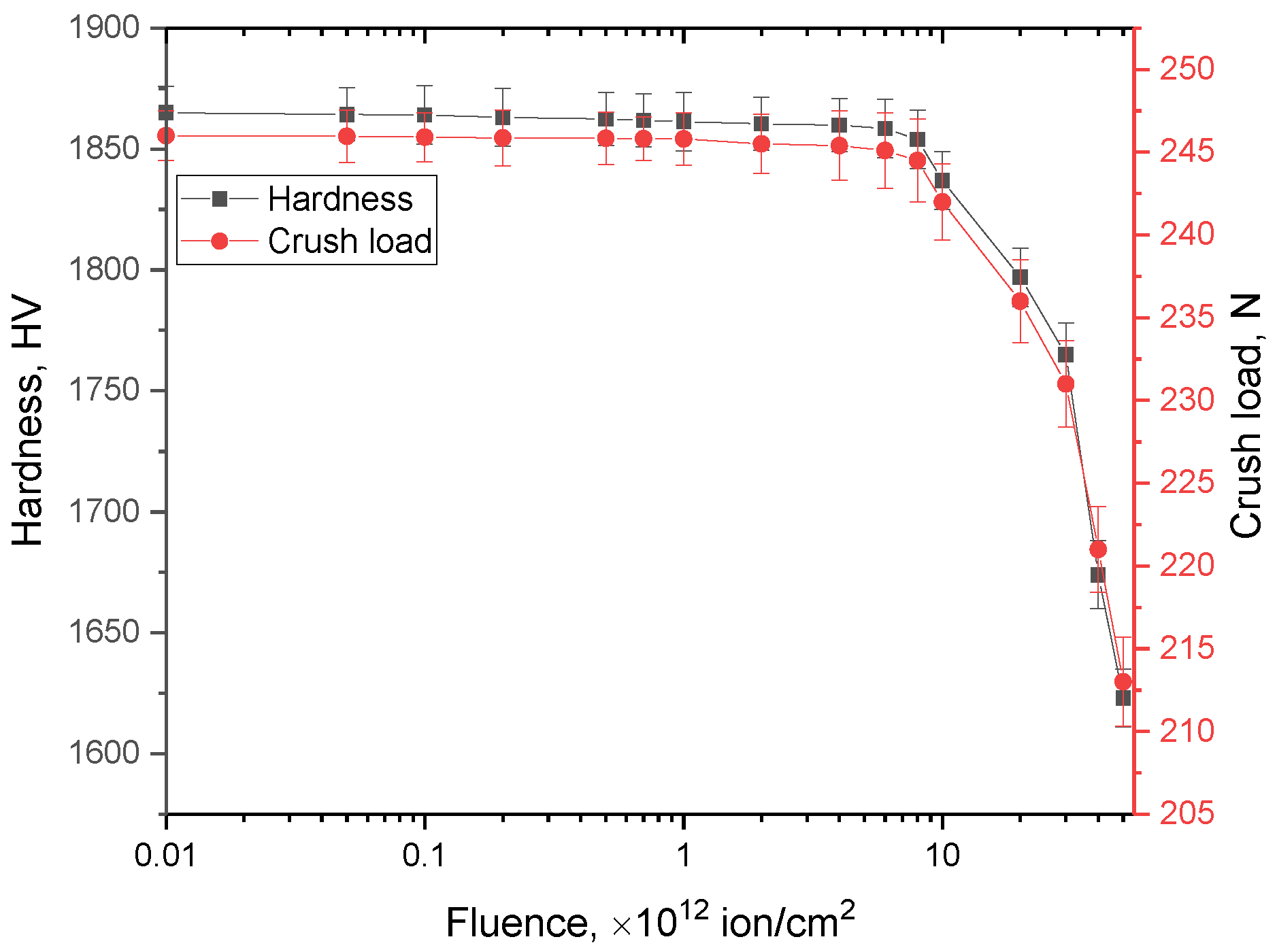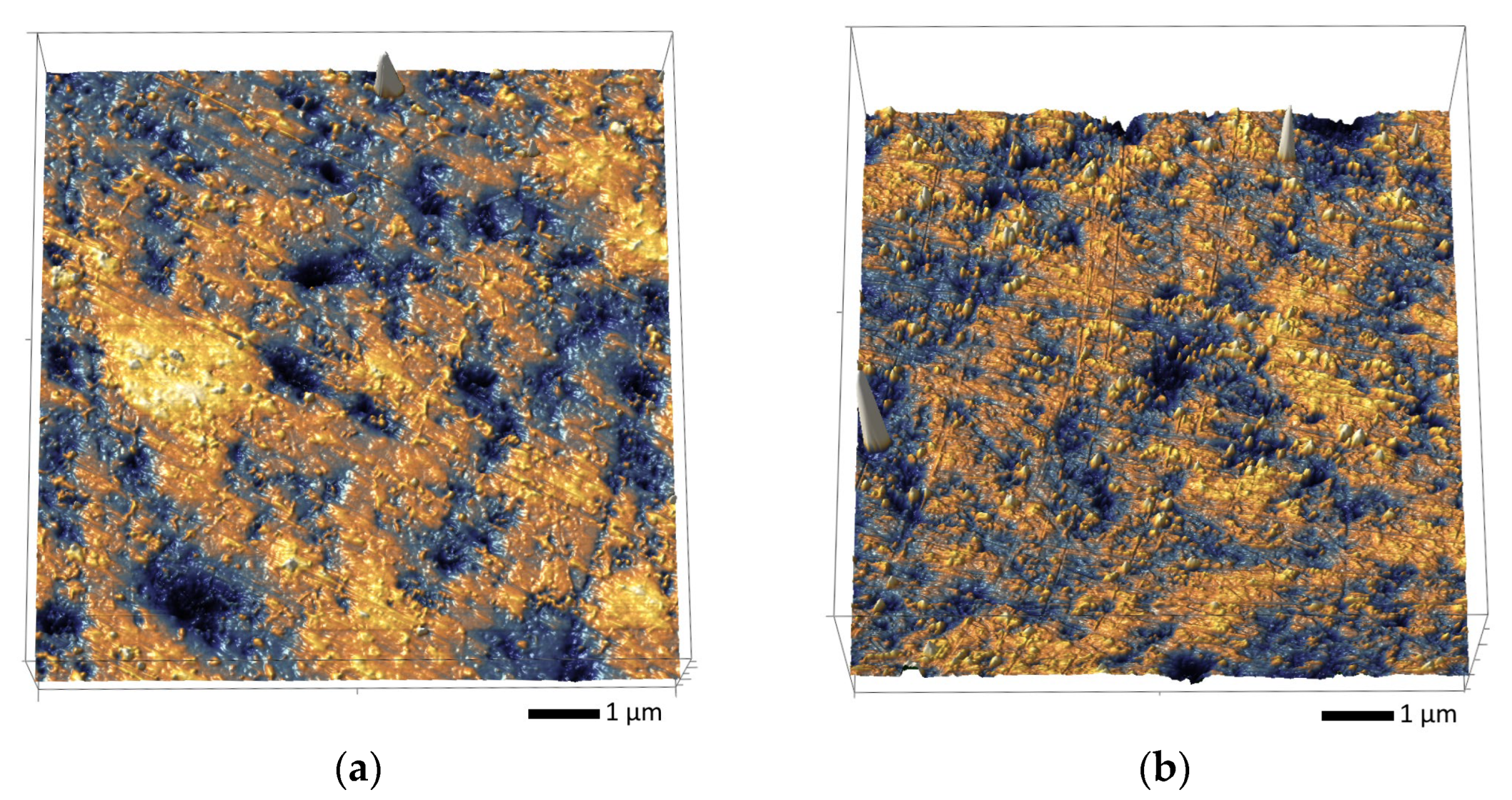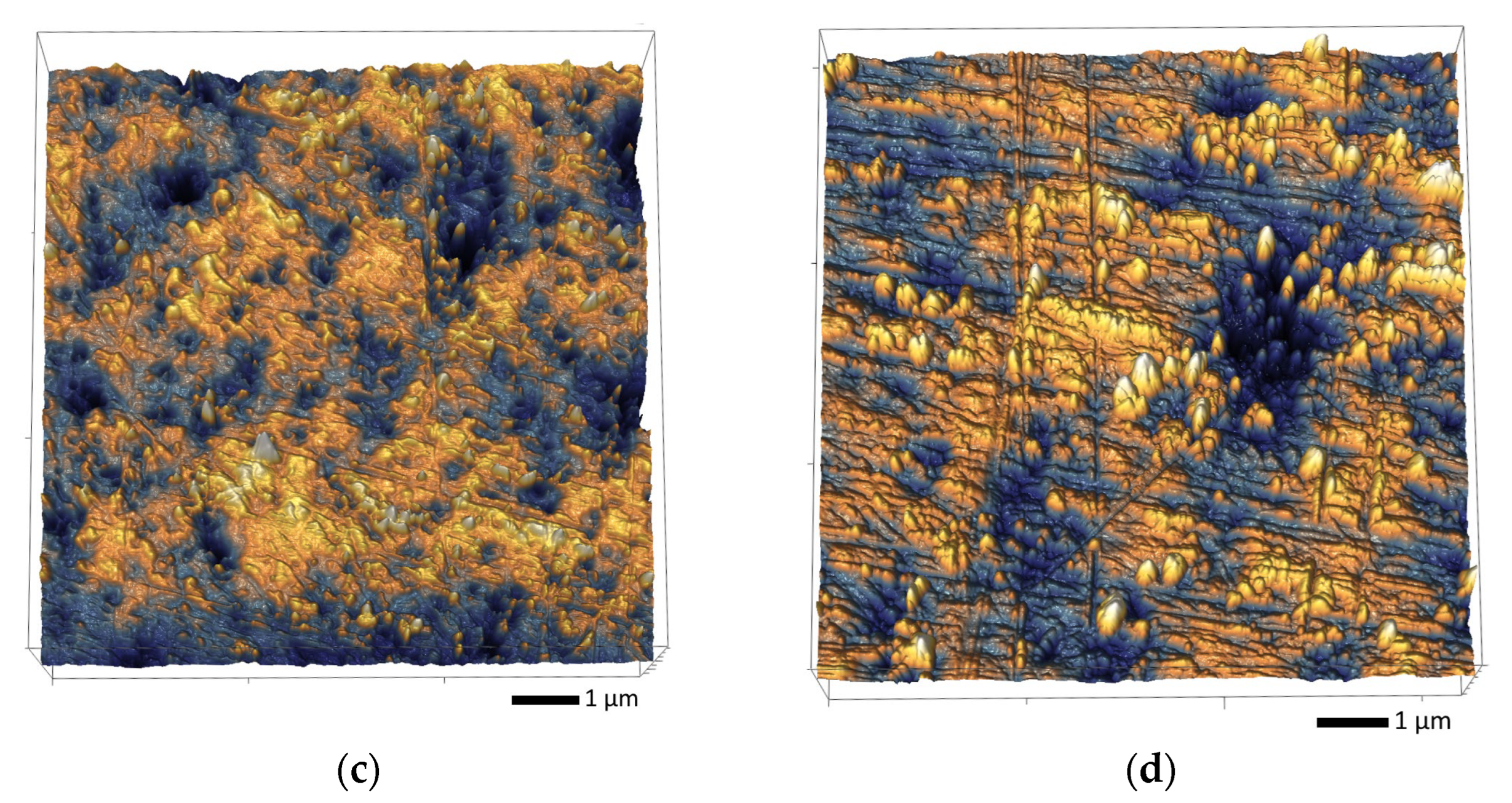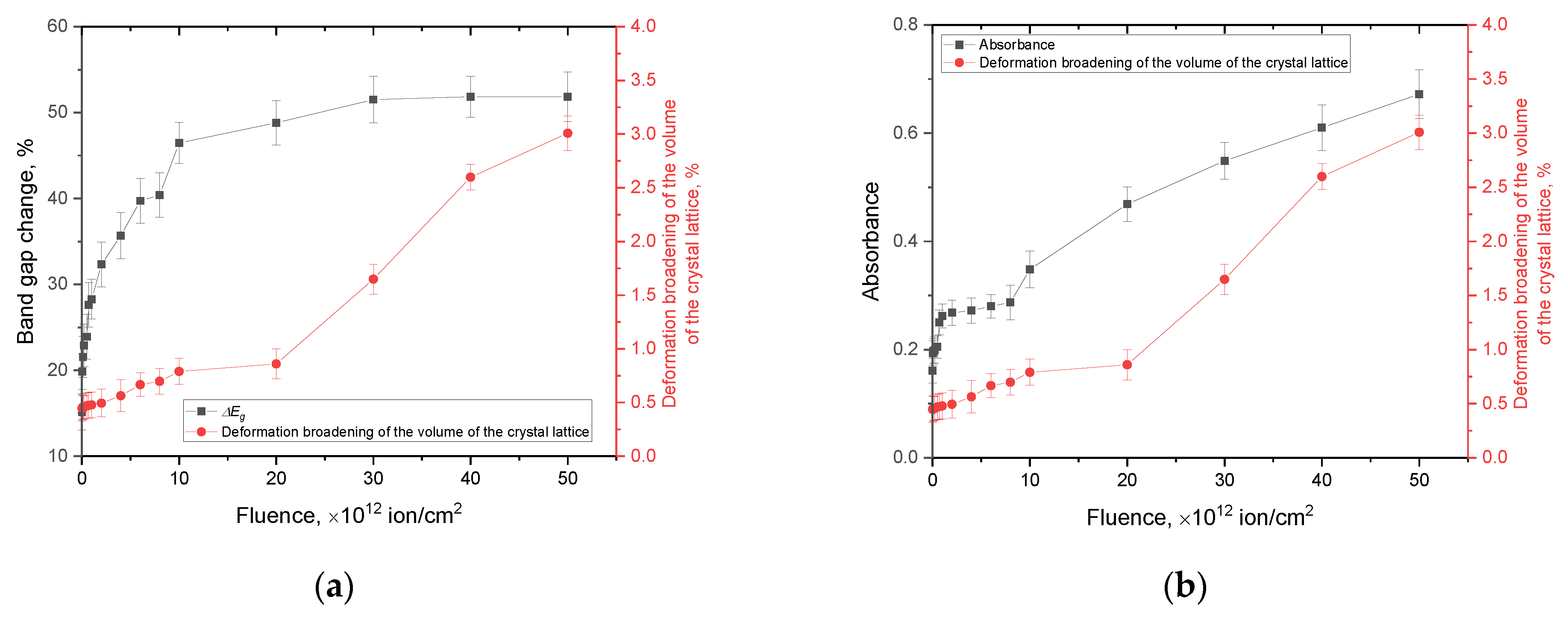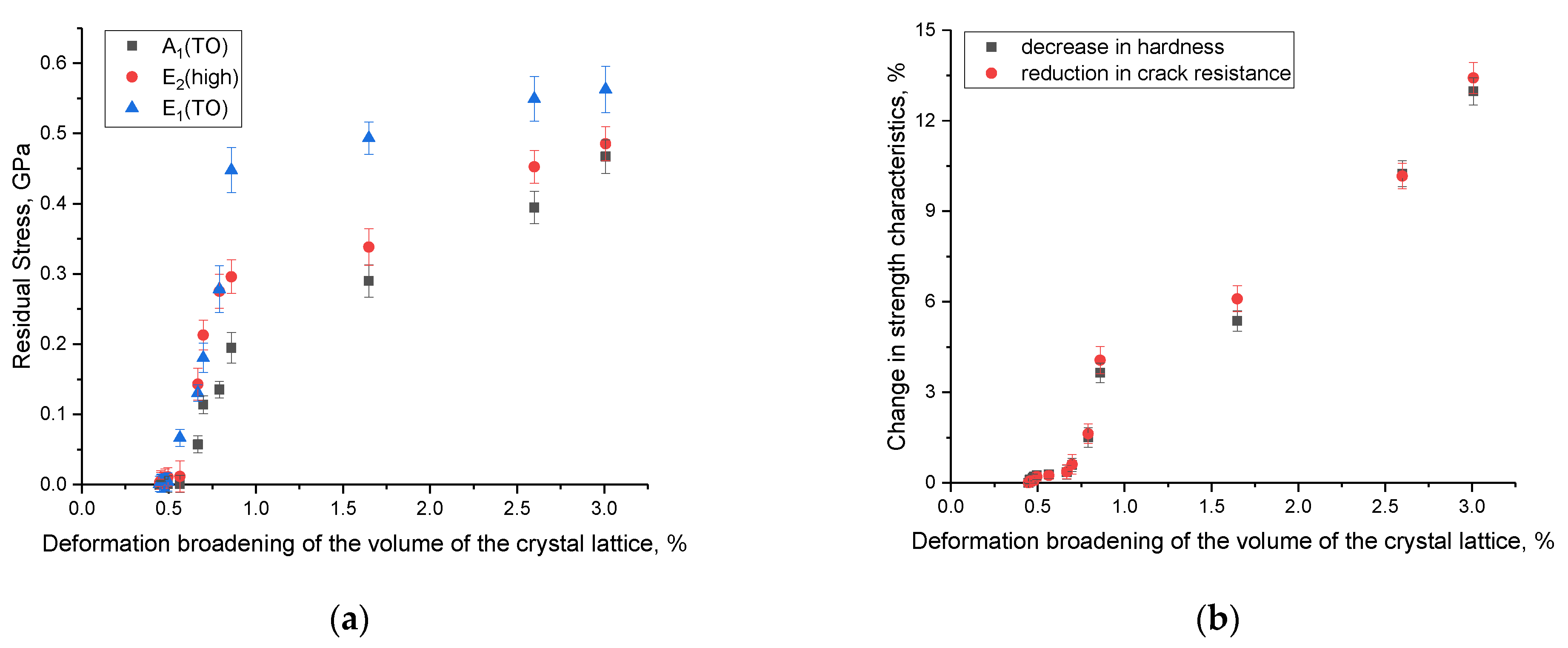3.1. Results of Changes in the Structural Characteristics of AlN Ceramics as a Result of Irradiation with Heavy Xe23+ Ions
Figure 2 shows the results of measurements of the X-ray diffraction patterns of the samples under study, performed in Bragg–Brentano geometry (2θ = 30–80°), reflecting the kinetics of changes in the structure of the ceramics depending on the irradiation fluence. Upon analyzing the presented X-ray diffraction patterns depending on the irradiation fluence, it was revealed that there were no changes linked to the formation of new reflections in the diffractogram or the appearance of the effect of reflection stratification, which indicates an absence of phase changes during the irradiation of the ceramics over the entire fluence range under study. The main observed alterations in the diffraction patterns presented are associated with insignificant variations in the intensity of the diffraction reflections, as well as their shift to a region of small angles at irradiation fluences above 10
12 ion/cm
2. In this case, the established changes indicate that the main processes associated with the accumulation of radiation damage in ceramics are due to structural deformation distortions, the type and nature of which depend on the irradiation fluence. At fluences below 10
12 ion/cm
2, the observed slight changes in the intensity of the main diffraction reflections, as well as their ratios, may be due to grain misorientation and textural effects that occur in the case of ionization processes in the damaged layer. Moreover, the absence of significant shifts of reflections relative to the position of the maxima in the initial state at fluences below 10
12 ion/cm
2 implies a high resistance of the crystal lattice of this type of ceramic to the ionization processes associated with the interaction of incident ions with electron shells. An analysis of changes in the intensities of diffraction reflections depending on the irradiation fluence showed that the most pronounced changes associated with a decrease in intensity, as well as the broadening of diffraction maxima, are observed for fluences above 5 × 10
12 ion/cm
2. The formation of an asymmetric shape of diffraction reflections, and a decrease in intensity, can be due to the effects of the accumulation of structural disorder in the damaged layer, as well as the formation of regions with high concentrations of stresses and strains. As the fluence increases, these structurally isolated regions approach each other. In this case, the resulting structural distortions within one isolated region can have a negative impact on the already existing structural distortions within a nearby region, thereby destabilizing the crystal structure. In this case, the resulting point defects and vacancies can begin to interact with each other, forming cluster or complex defects that have sufficiently high mobility in the damaged layer. The resulting deformation distortions, leading to the destabilization of the damaged layer at high densities, can lead to the appearance of structurally disordered regions characterized by the absence of any structural order (amorphous inclusions).
Moreover, the analysis of the obtained X-ray diffraction data for the studied ceramics irradiated with the maximum fluence (for this experiment) showed the presence of diffraction reflections that have only a distorted shape, which implies that these ceramics have a high level of resistance to amorphization processes as a result of irradiation in contrast to silicon nitride ceramics, for which the partial or complete amorphization of the damaged layer was observed at similar irradiation fluences [
33]. Also, the absence of variations associated with the formation of new diffraction reflections for irradiated samples, which characterize polymorphic phase transformations, indicates the resistance of the ceramic structure to these processes, which makes them more promising in comparison with ZrO
2 ceramics, for which these effects were established upon irradiation with heavy Kr and Xe ions [
34,
35].
One of the ways to assess the degree of influence of ionizing radiation on the crystal structure of a ceramic is to assess the deformation distortion of the crystal lattice, the nature of which indicates the resistance of a ceramic to radiation damage and also allows you to evaluate the kinetics of the accumulation of structural distortions and establish the main mechanisms of the deformation of the crystal structure. As a rule, the deformation distortions of the crystal structure in the case of a non-cubic type of crystal lattice are evaluated for each parameter separately, which makes it possible to establish not only the type of deformation distortion (tensile or compressive) but also the degree of distortion isotropy. In the case of an anisotropic distortion of the crystal lattice, the changes in the parameters will be uneven which, in turn, can result in the appearance of effects associated with the formation of metastable deformation inclusions in the structure.
Figure 3a shows the results of the estimation of the deformation distortions of the crystal lattice parameters
a and
c, characteristic of the hexagonal type, depending on the fluence of irradiation with heavy Xe
23+ ions, which characterize the structural distortion, as well as the resistance of the crystal structure to deformation distortions. The general view of the observed changes in the deformation distortions of parameters
a and
c depending on the irradiation fluence indicates that they can be characterized by several stages. The first stage is typical for irradiation fluences of 10
10–10
12 ion/cm
2 for which the observed changes correspond to small deformation distortions of the crystal lattice (less than 0.05%), while both parameters
a and
c change isotropically depending on the irradiation fluence (i.e., the difference in deformation distortions remains at the same level with an increasing irradiation fluence). With an increase in the irradiation fluence above 10
12 ion/cm
2, which is characterized by the formation of overlapping effects of structurally deformed regions, a more pronounced deformation of the parameter
c is observed, while the deformation distortion of the parameter
a is less pronounced. However, at fluences of 3 × 10
12–5 × 10
13 ion/cm
2, the reverse picture of the change in deformation distortions is observed with the distortions of parameter
a dominating. This difference can be explained by the appearance of the effect of overlapping defective regions at high irradiation fluences, leading to the anisotropic distortion of the crystal lattice. The anisotropic distortion of the crystal lattice parameters at irradiation fluences above 10
12 ion/cm
2 indicates an increase in structural deformations, the accumulation of which is accompanied by increases in various distorting factors, including the formation of vacancy complexes and cluster defects, the presence of which was confirmed in a number of works [
36,
37].
It should be noted that the positive values of distortions of the crystal lattice parameters indicate that the deformation distortion is due to swelling effects as a result of the accumulation of tensile stresses in the structure of the damaged layer. At the same time, the most pronounced changes in the crystal lattice parameters were observed for irradiation fluences above 10
12 ion/cm
2 at which, according to the data from a number of studies in the literature [
38,
39,
40], there is an overlapping effect of local structurally deformed regions that arise along the trajectory of the incident ions within the crystal structure of the target material.
Based on changes in the structural parameters and the volume of the crystal lattice, the concentration of the defective fraction (
Fd) was calculated using the formula
Fd = 1 −
, where
V and
Vc are the crystal lattice volumes before and after irradiation. The results are shown in
Figure 3b. The general view of the trend in changes in the concentration of the defective fraction corresponds to the trend in changes in the deformation distortions in the crystal structure, with a swift increase in concentration at fluences above 5 × 10
12 ion/cm
2, implying a cumulative effect, as well as the influence of the effect of the overlap of local structurally deformed regions, leading to an acceleration of the processes of the destruction of the crystalline structure of the damaged layer. The most pronounced deformation distortions, as is evident from the data presented, cause the accumulation of the defective fraction in the damaged layer and its exponential increase at the highest irradiation fluences. At the same time, deformation mechanisms are caused by tensile stresses and the subsequent swelling of the crystal lattice which, in turn, can lead to a deterioration in the strength characteristics of the material or the formation of hillocks on its surface due to the displacement of the deformed volume.
3.2. Study of the Effect of Irradiation on Changes in the Optical Properties of AlN Ceramics
One of the methods for assessing the effect of irradiation on the overall change in the properties of materials is the method of comparatively evaluating the optical transmission or absorption spectra of samples before and after external influences. As a rule, a change in an optical characteristic (transmission, optical density, or absorption) depending on external influences is associated with the accumulation of defective inclusions in the structure, as well as changes in the electron density associated with the redistribution of electrons on electron shells under the action of external forces.
Figure 4a demonstrates the results of variations in the optical UV-Vis transmission spectra depending on the fluence of irradiation with heavy Xe
23+ ions. The overall depiction of the observed transmission spectrum trends manifests as alterations in optical transmission within the 400 to 1000 nm range, encompassing both the visible spectrum and the near-infrared spectrum (above 780 nm). At the same time, for the irradiated samples, in addition to a change in transmittance in the measured wavelength range, there is also a shift in the fundamental absorption edge at the border of the ultraviolet and visible regions of 330–380 nm, with a shift of the edge toward the visible light region. The decrease in transmission intensity in the visible light and near-infrared ranges is due to an increase in phonon absorption associated with the accumulation of radiation damage. It should be noted that the greatest changes are observed at fluences of 10
10–5 × 10
12 ion/cm
2, for which not only is a shift of the fundamental absorption edge observed but a decrease in the transmission intensity is also observed, the change in which indicates the formation of changes in the damaged layer linked to the formation of point defects, as well as alterations in the electron density and its distribution near the trajectories of the incident ions when they pass through the ceramic.
An analysis of the absorption spectra presented in
Figure 4b made it possible to establish two characteristic types of variations related to alterations in the irradiation fluence. Firstly, for all the absorption spectra of the irradiated samples, an increase in the absorption intensity was observed over the entire measured range, which indicates a change in both the optical density characterizing the transmittance of the ceramics and an increase in the number of absorbing centers, leading to an increase in absorption and, as a result, a decrease in transmission.
An analysis of the dependences of the absorption spectra showed the formation of additional spectral absorption bands in the region of 3.38–3.40 eV at irradiation fluences of 5 × 10
11 ion/cm
2, which are characteristic of the formation of
ON–
VAl vacancy complexes. According [
41,
42], a similar absorption band at 3.35 eV, observed after reactor neutron irradiation at a dose of 10
16 n/cm
2 (
E > 0.1 MeV), was designated an F-type center from the optical absorption and electron spin resonance. Later, F centers were considered some of the main point defects in AlN nanotubes [
43]. Moreover, the intensity of the spectral absorption band for these vacancy complexes increases with a change in the irradiation fluence which, in turn, implies an elevation in the concentration of these
ON–
VAl complexes in the damaged layer. The presence of such inclusions in the form of
ON–
VAl is in good agreement with the data from a number of studies in the literature in which, as an explanation for the appearance of such complexes, they consider the mechanisms associated with the formation of defects and the subsequent recombination of donor–acceptor pairs associated with
VAl vacancies and oxygen atoms replacing nitrogen atoms. The presence of oxygen in the compositions of ceramics is associated with the processes of manufacturing ceramics, alongside the presence of stabilizing additives in the form of Y
2O
3 compounds. Also, the change in the intensity of the spectral line at 3.38–3.40 eV, which characterizes the formation of
ON–
VAl vacancy complexes, can be considered an indicator of structural damage in ceramics during irradiation. At the same time, the absence of this spectral line at low irradiation fluences (below 5 × 10
11 ion/cm
2) indicates that the formation of these vacancy complexes occurs only when the distance between local structurally changed regions becomes very close.
A change in the band gap as a result of the accumulation of radiation damage with an increase in the irradiation fluence can lead to an increase in the effects associated with the ionization of the substance in the damaged layer since the ionization energy is directly dependent on the band gap (See
Figure 5). As a result, the optical transmission spectra show a shift in the fundamental absorption edge to the region of long wavelengths, as well as a decrease in the transmittance of the ceramics in the entire measured range. In this case, the decrease in transmittance can also be explained by a change in the value of the refractive index, which has an inverse dependency on the band gap. An increase in the refractive index, in turn, indicates an increase in defects in the structure of a ceramic, an increase in the concentration of which occurs with an increase in the irradiation fluence and, as a consequence, the formation of structurally disordered regions in the structure.
The observed shift in the approximating curve, which determines the value of the band gap, indicates its decrease with an increase in the fluence of irradiation with heavy ions. Such effects, as shown in [
44,
45], are primarily due to the creation of localized states in the band gap which lead to changes in the electron and optical densities, respectively. The resulting high-energy photons can lead to the formation of electronic transitions between extended states in the valence band and the conduction band, which leads to a change in the band gap.
Figure 6 shows the dependences of the estimation of the change in the optical characteristics of the band gap and the linear refractive index of AlN ceramics upon irradiation with heavy Xe
23+ ions.
The overall view of the presented changes in these values indicates a two-stage nature of the change depending on the irradiation fluence. At low irradiation fluences of 1010–1012 ion/cm2, there is a sharp decrease in the band gap and an increase in the linear refractive index, which characterizes an increase in the absorbing ability of ceramics. At fluences above 1012 ion/cm2, there is a slowdown in the trends of changes in these values, and in the case of irradiation fluences of 3 × 1013–5 × 1013 ion/cm2, there are practically no changes in these values. Such an effect can be explained by the saturation of changes in the electron and optical densities since at these irradiation fluences, as was found in the analysis of alterations in structural parameters, a steep increase in the deformation distortions of the structure is observed.
3.3. Determination of the Kinetics of the Formation of Residual Mechanical Stresses in the Damaged Layer of AlN Ceramics Using the Method of Raman Spectroscopy
Figure 7 shows the results of measurements of the Raman spectra of the studied AlN ceramics depending on the fluence of irradiation with heavy Xe
23+ ions. The spectra are presented as the dynamics of three main spectral lines, A
1(TO), E
2(high), and E
1(TO), the changes in which characterize the kinetics of structural changes caused by external influences, as well as the formation of vacancy complexes of the
ON–
VAl type in the structure which arise during the accumulation of structural distortions in ceramics.
By analyzing the kinetics of the changes in the Raman spectra of the main spectral lines characteristic of aluminum nitride, A
1(TO), E
2(high), and E
1(TO), the following conclusions can be derived. First of all, the obtained spectra do not show the appearance of any new spectral lines, which indicates the preservation of the chemical order in the structures of the ceramics as a result of irradiation, as well as the absence of structural transformations caused by the accumulation of defects or ionization processes leading to a change in the electron density distribution. Secondly, the main observed changes in the spectral lines are due to two factors: the shift of the lines relative to the initial position of the maxima and the changes in their shape and linewidth (an increase in which characterizes the effect of amorphization as a result of the accumulation of radiation damage). The results of these fluctuations in two quantities (the shift in the maximum of the spectral lines and the FWHM) are shown in
Figure 8.
An analysis of the shifts in the main spectral lines of the Raman spectra and the FWHM values shown in
Figure 8 depending on the irradiation fluence indicate the cumulative effect of structural deformation distortions, which are most pronounced at a fluence above 10
12 ion/cm
2. In the case of low irradiation fluences, almost no alterations in the shifts of the spectral lines and FWHM values are observed, which implies a high level of resistance of the ceramic’s crystal structure to the occurrence of residual mechanical stresses in the damaged layer during the formation of isolated, structurally changed regions along the trajectory of the ions’ motion in the ceramic.
At fluences above 1012 ion/cm2, a positive increase in the displacement of the position of the spectral line maxima is observed which is characteristic of deformational distortions in the crystal lattice, and the dynamics of the displacement increase indicate a cumulative effect. At the same time, a similar trend is also observed for the FWHM value, an elevation in which indicates the formation of disordered, amorphous-like inclusions in the structure. Moreover, the obtained dependences of the changes in the values of the shifts of the spectral lines and the FWHM are in good agreement with the data on the deformation distortions of the crystal lattice measured using the X-ray diffraction method. This agreement indicates that the deformation mechanism of the structural changes is linked to the accumulation of crystal lattice distortions, alongside the formation of vacancy complexes of the ON–VAl type, the presence of which was established using Raman spectroscopy (line shift), as well as the analysis of optical absorption spectra. At the same time, it should be noted that the dynamics of changes in the shift values of the spectral lines, as well as the FWHM values for the three spectral lines A1(TO), E2(high), E1(TO), have the same trend in both the region characteristic of isolated defects and at fluences characteristic of the effects of overlapping defective regions and the formation of amorphous-like inclusions.
Based on changes in the positions of the spectral lines and their shifts, the values of residual mechanical stresses in the damaged layer were calculated, the presence of which is related to the processes of the transformation of the kinetic energy of incident ions during collisions with electrons and nuclei into thermal energy, as well as the subsequent processes of the deformation distortion of the crystal structure. The connection between the shifts in the spectral lines and the residual mechanical stresses (
σxx) was established in [
46,
47], according to which, using the difference in the positions of the maxima of the spectral lines (∆
ω) and the expression ∆
ω =
kσxx, where
k = 3.7 cm
−1/GPa is the strain coefficient, one can estimate the magnitudes of residual mechanical stresses in the damaged layer depending on the irradiation fluence. Moreover, the sign “+” or “−” in the calculations of these values characterize the type of residual mechanical stresses associated with tensile (“+”) or compressive stresses (“−”). The results of calculating the values of residual mechanical stresses for the three main spectral lines A
1(TO), E
2(high), E
1(TO) are revealed in
Figure 9, the general trend of which indicates that structural distortions in the structure of the damaged layer are due to tensile residual stresses resulting from the processes of the interaction of heavy ions with the crystal structure. At the same time, the most pronounced growth in the magnitudes of residual stresses in the damaged layer is observed in the range of 10
12–10
13 ion/cm
2, in which there is an almost two- to threefold increase in the value of
σxx, while at fluences above 3 × 10
13 ion/cm
2, an increase in fluence leads to a slowdown in the trend of the accumulation of residual stresses in the structure of the damaged layer. The deceleration in the accumulation of
σxx can be rationalized via the presence of amorphous-like inclusions forming within the ceramic structure at these fluence levels. An elevation in their concentration results in the partial amorphization of the damaged layer, contributing to its deterioration. However, the concentration of these inclusions is low, as evidenced by the dynamics of the changes in the FWHM values of the Raman spectra and their intensities.
The parameters of total and chemical disorder caused by the irradiation of the crystal structure were determined by estimating the integral areas of the Raman spectra. An estimate of the total disorder was calculated using the ratios of the integral areas of the modes of the Raman spectral lines before and after irradiation. The chemical disorder was determined via the ratio of the integral areas and the intensities of the modes characteristic of Al–N chemical bonds. The results of a comparative analysis of the ratio of the contributions are shown in
Figure 10. The general trend of the changes in the contributions of total and chemical disorder has a good correlation with the concentration of defects formed as a result of the interaction of incident ions with the crystal structure of the target in the damaged layer. The dependence itself can be divided into three characteristic stages associated with both the concentration dependence of the accumulation of defects and the consequences caused by this accumulation.
The initial phase exhibits minor alterations in both chemical and complete disorder, implying that locally isolated, structurally distorted defect regions are formed in the structure of the damaged layer, the concentration of which is low enough to affect the changes in the properties of the ceramics. Moreover, in this case, an increase in the density of these locally isolated defect regions leads to an increase in the chemical disorder caused by changes in Al–N chemical bonds as a result of their deformation or the formation of vacancy complexes.
The second stage is typical for fluences above 1011 ions/cm2 for which, in addition to an increase in the contribution of chemical disorder, an increase in the total disorder is also observed, an increase in which indicates a deformation distortion of the crystal structure as a result of an increase in the density of locally isolated regions, as well as the accumulation of point and vacancy defects. In this case, upon reaching the effect of the overlap of structurally distorted regions, an increase in chemical disorder as a result of an increase in the randomization of Al–N chemical bonds occurs, alongside the formation of vacancy complexes of the ON–VAl type, an increase in the concentration of which is clearly seen in the absorption spectra.
The third phase is marked by sudden increases in both total and chemical disorder which can trigger the onset of partial amorphization processes resulting from the accumulation of structural distortions and deformations in the damaged layer. In this case, locally deformed or structurally disordered regions can form in the structure, the presence of which leads to the amorphization of the damaged layer.
An essential factor influencing the determination of the potential application of ceramics as structural materials is the assessment of the stability of their strength and mechanical properties as a result of the accumulation of radiation damage in their near-surface layers. Furthermore, variations in the strength properties of ceramics are directly linked to the presence of defective inclusions that arise during high doses irradiation and to deformation distortions stemming from the accumulation of residual mechanical stresses.
Figure 11 reveals the results of mechanical tests of the studied ceramics depending on the irradiation fluence, characterizing the changes in the strength properties of the ceramics in the case of the accumulation of structural changes in the damaged layer. The general trends in changes in the values of hardness and load resistance under a single compression are in good agreement with the data on changes in structural parameters linked to the accumulation of deformation distortions in the structure. The main changes in the strength characteristics are observed when the irradiation fluence reaches more than 10
12 ion/cm
2, which, as was previously shown, are characterized by the formation of structurally deformed regions and residual mechanical stresses linked to the cumulative effect, alongside the formation of overlapping defect regions.
Figure 12 shows the results of the assessment of changes in the surface morphology of the AlN ceramics before and after irradiation with heavy Xe
23+ ions at different fluences. The data are presented as reconstructed 3D images of the surfaces, which were obtained using the atomic force microscopy method.
An analysis of morphological features obtained by constructing 3D images of the ceramics’ surface profiles showed the formation of hillock-like inclusions on the surfaces of the irradiated ceramics; the number of inclusions increases at high irradiation fluences. In irradiated ceramic samples, the formation of hillocks, as shown in a number of works, is associated with the displacement of the surface volume in places of the accumulation of deformation distortions, which leads to the formation of spherical inclusions, the size of which can vary from several to hundreds of nanometers. Moreover, the densities of such inclusions and their sizes have pronounced dependences not only on the irradiation fluence but also, according to data from the literature, on the energy and type of incident ions. At the same time, it should be noted that at the maximum irradiation fluence, an increase in the size of the hillocks is observed, as well as the formation of small agglomerates from them which, in turn, is consistent with a sharp increase in deformation distortions in the damaged layer and the accumulation of residual mechanical stresses in the crystal structure, leading to its swelling.
Thus, it can be concluded that the accumulation of deformation distortions and residual mechanical stresses in the damaged layer of a ceramic results in the displacement of the deformed volume to the surface, resulting in the formation of pyramidal or spherical inclusions, the density of which increases with the irradiation fluence.
3.4. Establishing the Relationship between Structural Distortions and Changes in the Optical and Strength Properties of Ceramics under Irradiation with Heavy Ions
Figure 13 demonstrates the results of a comparative analysis of fluctuations in the optical characteristics and structural distortions of the crystal lattice (volume swelling), reflecting the effects of irradiation on these characteristics. This analysis is presented in order to establish a relationship between changes associated with the accumulation of deformation distortions in a structure and its optical properties (the band gap and absorbance).
Figure 14 presents the data from a comparative analysis of the values of the volumetric swelling deformation of the crystal lattice and residual mechanical stresses, as well as changes in its strength properties as a result of the structural degradation of the damaged layer.
By analyzing the obtained dependences of alterations in the optical, structural, and mechanical properties of the AlN ceramics on the irradiation fluence, we can draw the following conclusions. At low irradiation fluences, which are characteristic of the formation of isolated, structurally deformed regions, ionization losses play a dominant role, leading to changes in the electron density due to the formation of localized states, as well as vacancy complexes, the presence of which results in the appearance of additional electronic transitions. Moreover, at low irradiation fluences, structural distortions of the crystal lattice practically do not manifest themselves, which indicates the material’s resistance to a low concentration of defective inclusions and the formation of isolated deformation distortions.
At fluences above 1012 ion/cm2, the dominant role is played by tensile residual mechanical stresses resulting from the effect of overlapping structurally deformed regions, as well as an increase in the deformation distortions of the crystal lattice. In this case, there is practically no change in the optical characteristics, particularly changes in the band gap at high irradiation fluences, while deformation distortions prevail under high doses of irradiation.
When comparing the deformation swelling of the crystal lattice and optical density data, a good correlation of these values is established, indicating the cumulative effect of deformation structural distortions that affect both the structural characteristics and the absorbing ability of ceramics. However, it should be noted that the linear nature of the change in the optical density (absorbance) with an increase in the irradiation fluence above 5 × 10
12 ion/cm
2 indicates not only the cumulative effect of structural deformations that change the absorbing ability of ceramics due to the formation of defective inclusions and vacancy complexes but also a direct correlation between the absorption capacity and the deformation distortion of the crystal structure. In this case, the obtained dependences of the change in optical density are in good agreement with data from a number of studies in the literature in which the change in this value characterizes the relationship between structural distortions and the absorbing ability of a material [
48,
49,
50].
The dependences of changes in the values of residual mechanical stresses on the value of the deformation swelling of the crystal lattice presented in
Figure 14a are in good agreement with each other, which is expressed in the cumulative effect of structural distortions, accompanied by an increase in the contribution of residual mechanical stresses in the damaged layer. At the same time, the most pronounced correlations of these values are observed at fluences above 5 × 10
12 ion/cm
2 when an overlap of structurally deformed regions is observed in the structure, leading to a sharp increase in the deformation of the crystal lattice.
The dependences of the degradation of strength characteristics on the deformation of the crystal structure determined in
Figure 14b also have a good correlation with each other, indicating that the greatest influence on softening is made by the accumulation of residual mechanical stresses and deformation distortions. At the same time, in the case of the dominance of ionization effects associated with changes in the optical characteristics of ceramics at low irradiation fluences, changes in strength characteristics are practically not observed.
It is important to highlight that the analysis of the structural parameters and changes in the Raman spectra for AlN ceramics depending on the irradiation fluence did not reveal a high concentration of amorphous inclusions leading to the complete amorphization of the damaged layer, which is observed for Si3N4 ceramics, indicating a greater structural resistance of aluminum nitride to the accumulation of radiation damage. One of the explanations for such differences for the two classes of nitride ceramics may be that in the case of aluminum nitride, the crystal structure of the initial sample is represented by a single phase (hexagonal-like wurtzite), while most silicon nitride ceramics are a mixture of two phases, α and β. Hence, the accelerated amorphization processes in silicon nitride and the creation of latent tracks may be attributed to the impact of polymorphic transformations of the α↔β variety. Typically, these transformations coincide with a destructive alteration in the volume of the crystal lattice and an escalation of deformation distortions throughout phase transformations. In the case of the AlN ceramics, such effects were not observed, even with high doses of irradiation, and all the structural changes in the crystal lattice were associated with its deformation distortion and swelling.
